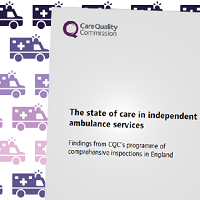The state of care in independent ambulance services is an analysis of the findings from our comprehensive inspection programme of independent ambulance services in England.

Overview
Independent ambulance providers mainly offer specialist patient transport services and non-emergency responses.
An increasing number also provide 999 emergency responses to support NHS ambulance trusts routinely or during times of peak demand.
What we did
This report is based on the findings from our programme of comprehensive inspections of the independent ambulance sector, which was completed in March 2018.
We analysed a sample of 26 published inspection reports for key themes. We carried out focus groups and interviews with staff to explore the themes further. The staff were involved in inspecting and registering independent ambulance services. We also analysed regulatory breaches found on our independent ambulance inspection visits.
What we found
The key findings from our comprehensive inspection programme are:
- the quality and safety of independent ambulance services varies greatly
- many services had a poor understanding of governance which often led to weak recruitment processes
- checks to make sure staff had the appropriate employment references, Disclosure and Barring Service (DBS) certificates, and driving licence categories (for example to operate heavier vehicles) were not being enforced consistently
Also many providers offered no or very limited staff training. In particular:
- emergency driver response training for the skills required to transport a patient using blue lights or sirens
- training to equip staff to recognise and escalate safeguarding concerns
- training to support patients with mental health needs
The standard of medicines management was variable. Some services had robust policies to support the safe administration of medication. Others showed a lack of understanding, especially around controlled drugs. Some did not have a Home Office licence for the procurement and storage of controlled drugs.
Inspectors found some good practice in infection control and vehicle maintenance. There was evidence of ambulances and stations having regular deep cleans, up-to-date MOTs and insurance cover. In other cases they found:
- vehicles had not been regularly serviced
- missing or faulty equipment (including paediatric apparatus for transporting children in emergencies)
- no regular equipment checks
Wider sector
The report also raises concerns about those independent ambulance services that are exempt from CQC regulation.
An example of an exempt service is medical cover at temporary events. The current lack of oversight is putting people at risk. We're working closely with local authority event licensing boards and other relevant bodies. We need to make sure they understand their responsibilities for patients' safety.
We have highlighted our concerns to the Department of Health and Social Care. We have recommended reviewing the regulations to address the existing regulatory gap.